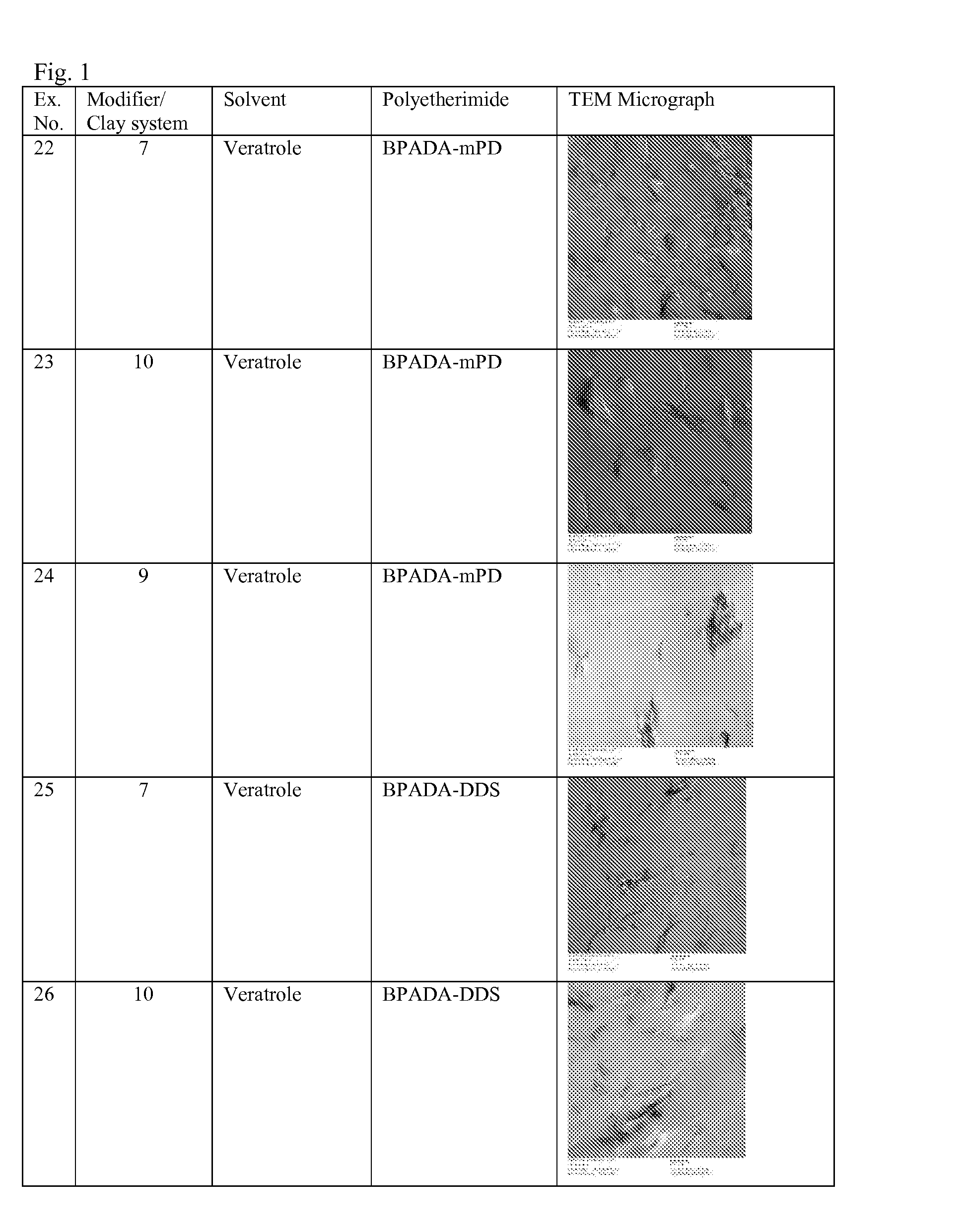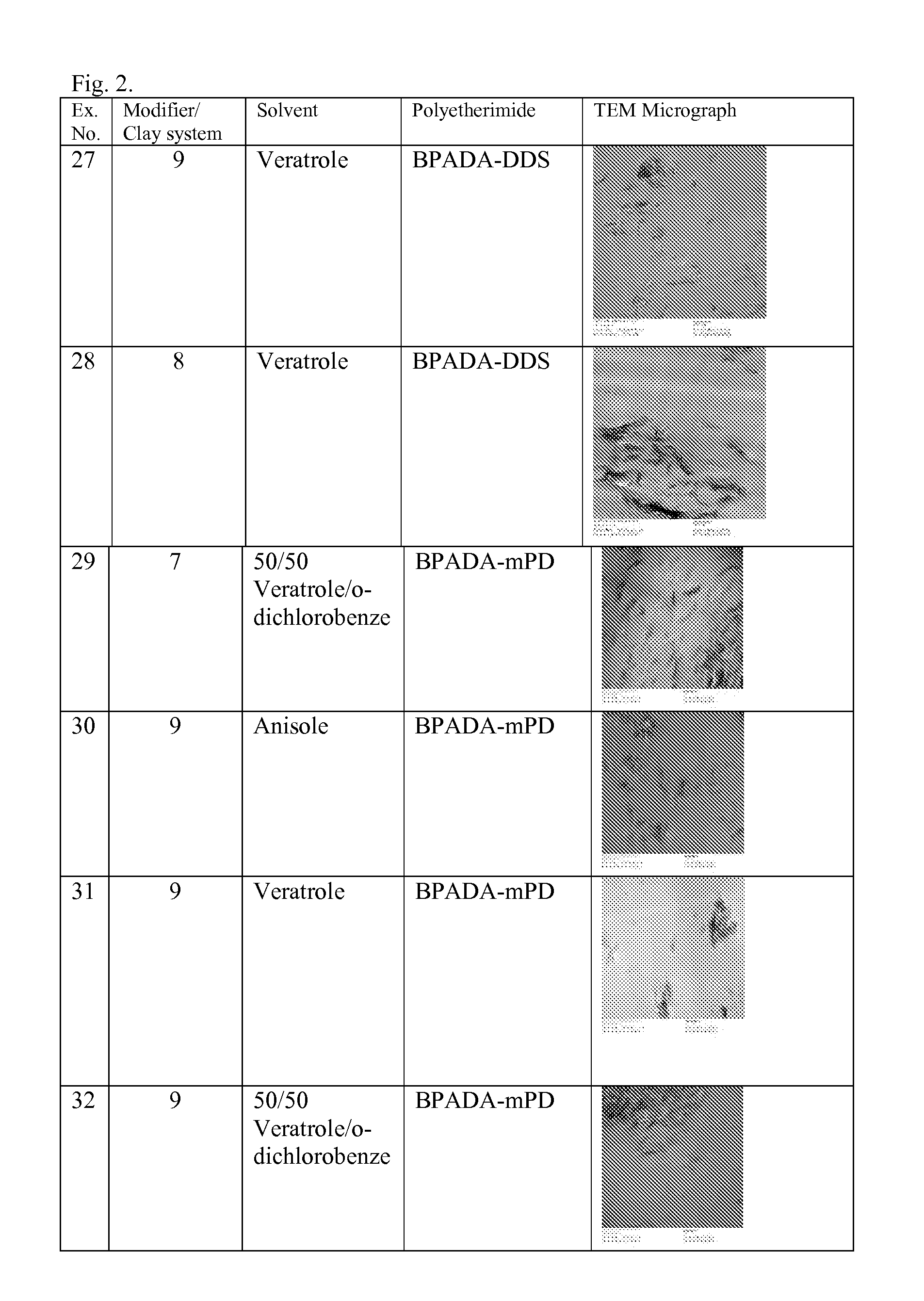Methods of preparing polymer-organoclay composites and articles derived therefrom
a technology of organic compounds and composites, applied in the field of methods of preparing polymerorganoclay composites, can solve the problems of film failure and adhesion
- Summary
- Abstract
- Description
- Claims
- Application Information
AI Technical Summary
Benefits of technology
Problems solved by technology
Method used
Image
Examples
example 1
Part B
[0266] Detailed example: 2.0 g of Na+ MMT clay (cation exchange capacity of 0.000926 mols Na− / g of clay; 0.001852 mols of cations total) was dispersed in 200 mL of a 50 / 50 mixture of deionized water and ethanol and brought to reflux. Tetraphenylphosphonium bromide (1.4167 g, 0.002216 mols) was added and the dispersion was allowed to stir at reflux for two hours. The mixture was cooled to room temperature and transferred to four 50 mL centrifuge tubes. The tubes were placed on a centrifuge and spun at 3000 rpm for 5 min. The supernatant was poured off, the clay was redispersed in a fresh mixture of 50 / 50 deionized water and ethanol to wash the remaining solid, and solid was again collected again by centrifugation. The wash procedure was repeated twice more. Following the final centrifugation and decantation the remaining solid was dried in a 120° C. oven for two hours and then ground to a fine powder. Table 1 shows the properties of organic modified montmorillonite organoclay....
example 2
Solvent Cast Film Comprising Polyimide-Organoclay Composite
[0267] Tetraphenylphosphonium treated montmorillonite clay from Example 1 (TPP-MMT) was dispersed in NMP with the aid of sonication. Oxydianiline (ODA) was added to the resulting solution and mechanically stirred until the diamine was completely dissolved at room temperature. Oxydiphthalic dianhydride (ODPA) was then added to the solution and dispersed with mechanical stirring to form a viscous poly(amic acid) solution at 20 wt % solids. The solution was allowed to react at room temperature for 12 hours. The solution was cast onto a glass substrate at 70° C. and imidized by successive heating at 70° C. for 2 hours, 150° C. for 4 hours, 200° C. for 1 hour and 300° C. for 1 hour. The resulting nano filled polyimide film was peeled from the glass substrate for testing. Results are shown in Table 2.
TABLE 2CTENormalized(ppm / ° C.)% CTE% CTEEx.Wt. %2nd scanReductionReductionNo.PolymerNanoclaySilicate(0-200)(2nd scan)(2nd scan)2A...
example 3
Preparation of (3-Aminophenyl)triphenylphosphonium Iodide (18)
[0268]
[0269] To a 3000 mL 3-necked round-bottomed flask fitted with a condenser, mechanical stirrer and gas inlet, about 329.33 g (1.25 mol) of triphenylphosphine (PPh3), Pd(acetate)2 (2.82 g, 0.0126 mol) and 1600 mL of de-gassed xylene was added. The mixture was stirred under argon until the PPh3 is dissolved. m-Iodoaniline (about 275.00 g; 1.25 mol) was added and the yellow-orange solution was refluxed for around 80 minutes. The product phosphonium compound ((3-aminophenyl)triphenylphosphonium Iodide) separated from solution as a yellow-orange solid. Excessive refluxing was avoided to prevent discoloration of the product phosphonium compound. The progress of the reaction was monitored using thin layer chromatography (TLC) with a 50 / 50 hexane / ethyl acetate developing solution. After the reflux, the product was filtered. The product 15 was reslurried with hot toluene, and stirred for 15 minutes. The solution was then fil...
PUM
| Property | Measurement | Unit |
|---|---|---|
| glass transition temperature | aaaaa | aaaaa |
| thickness | aaaaa | aaaaa |
| Tg | aaaaa | aaaaa |
Abstract
Description
Claims
Application Information
 Login to View More
Login to View More - R&D
- Intellectual Property
- Life Sciences
- Materials
- Tech Scout
- Unparalleled Data Quality
- Higher Quality Content
- 60% Fewer Hallucinations
Browse by: Latest US Patents, China's latest patents, Technical Efficacy Thesaurus, Application Domain, Technology Topic, Popular Technical Reports.
© 2025 PatSnap. All rights reserved.Legal|Privacy policy|Modern Slavery Act Transparency Statement|Sitemap|About US| Contact US: help@patsnap.com



